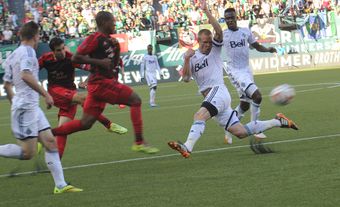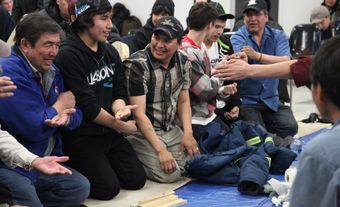Lawn bowling, or "bowls," is a game played on a flat lawn or green at least 36.6 m2. In a match, the object is to roll bowls so that as many as possible are nearer to the "jack" (a smaller white bowl) than the nearest opposing wood. Bowling can be traced back to ancient Egypt. The game spread to Greece and Rome and thence through medieval Europe to Britain, where it has been played since the 13th century. Scotland, where a code of rules was formulated in 1848, is considered the home of the modern sport.
Lawn bowling was brought to Canada by British garrison officers; the first bowling green in Canada was constructed on the garrison grounds at Annapolis Royal, NS. By 1888, a tournament was staged in Toronto, involving 7 clubs. The game's popularity grew during the latter part of the 19th century. The Dominion Lawn Bowling Tournament was inaugurated in 1892. The game flourished from the turn of the century into the 1930s. In 1901, the "points playing" system was introduced and electric lights were first used for late-evening play. The first Canadian touring team travelled to Britain in 1904, and 2 years later a British team toured Canada. The 1913 Canadian team to Britain was the most successful of such groups; it won 17 matches, lost 13 and tied one.
National organizations have been formed to promote the game. The Dominion Lawn Bowling Association (later the Canadian Lawn Bowling Council) was founded in 1924; its first national championships were held in 1954. Until 1971, women lawn bowlers were associated with clubs affiliated with the CLBC, but in that year the Canadian Ladies' Lawn Bowling Council was organized, and since 1972 men's and women's national championships have been held jointly. In 1983, the men's and women's national associations amalgamated to form Lawn Bowls Canada, which in 1999 was re-named Bowls Canada Boulingrin, in consideration of the many different surfaces (ie, indoor carpet, short mat) on which the game is currently enjoyed.
Canada was admitted to the International Bowling Board in 1928. Canadian men bowlers have participated in the British Empire and Commonwealth Games since 1930, winning silver medals in 1930, 1934 and 1954. Men's teams have also entered the world bowls championships since their inception in 1966. In 1980, after a long period of low rankings, the Canadian pairs team won the silver medal at the world championships. Women's teams have entered the women's world bowls championship since 1969, their best showing being a silver medal in the singles event, won by June Bell in 1977. Canada hosted the 1981 women's world bowls in Willowdale, Ont, and in 1982, the women's team entered the first women's Commonwealth Games event. In the 1986 Commonwealth Games, the Canadian men's team earned a silver medal in pairs and fours, fourth place in singles and first overall in team standings.
Notable international achievements during the 1990s include a silver medal in men's pairs at the 1990 Commonwealth Games. At the 1992 world championships, Canadian men placed second in the fours event, and third in pairs. In 1994, the Commonwealth Games were held in Victoria, BC, and the lawn bowls legacy facility from these Games remains at that city's Juan de Fuca Recreation Centre; several Canadian and international lawn bowls events have since been staged there.
There are over 18 000 lawn bowlers in Canada, registered with 271 clubs across the country. National and provincial competitions are organized in men's, women's, junior, senior, mixed and blind categories.

 Share on Facebook
Share on Facebook Share on X
Share on X Share by Email
Share by Email Share on Google Classroom
Share on Google Classroom


